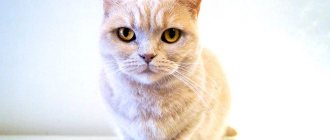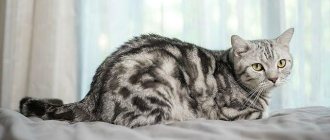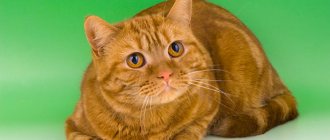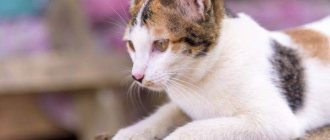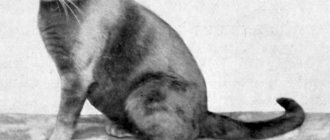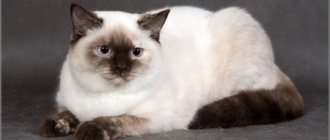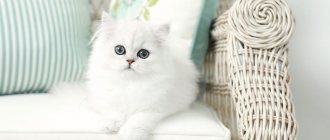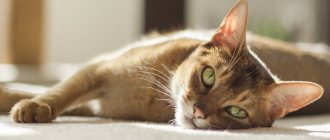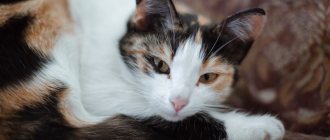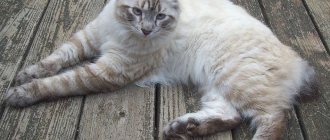11/13/2021 11,768 Cat breeds
Author: Olga
Fans of British cats know that this breed comes in a wide variety of colors. Today we will talk about lilac cats. Kittens of this breed are in demand among buyers, because a kitten with spectacular pinkish-smoky fur cannot leave anyone indifferent. What are the features of purple pets - find out from our article, and also enjoy photographs of these cute animals.
[Hide]
Features of the color of the breed
British Shorthair cats have an ancient pedigree descending from English cats. Animal lovers often associate them with English aristocracy and severity. Therefore, lilac and pinkish colors for this breed look very exotic. This feature of the coat, like the chocolate color, is usually attributed to oriental breeds: Siamese and oriental cats. So where did the purple brothers come from among the British?
These amazing Britons appeared thanks to the efforts of breeders. Contrary to popular belief, there is no separate gene responsible for purple coloration. This feature is the result of bleaching chocolate-colored cats and cats, just as blue is obtained by bleaching black, and cream is obtained by bleaching red. The history of the origin of lilac color in British cats is very short and is associated with the development of the color point breed. Interestingly, the new breed has become even more popular than the Color Point.
It is worth noting that breeders have made a lot of effort to ensure that British parents have a lilac-colored kitten. By the way, another name for this color is lilac. In person, it resembles blooming lavender, but even in photos, kittens and cats in the Lilac shade look mesmerizing.
How do you get such beauties?
Breeders of mustachioed beauties have been working on obtaining the “lilac” shade for a long time. To get a baby with the desired shade of fur, genes of a certain type must be present in the genotype of the parents. In our case, these are the chocolate shade gene and the lightening gene. Initially, purple babies were obtained by crossing two individuals with such genes, that is, the parents were of different colors. Now that the work of breeders has been crowned with success, breeding Lilac pets has become much easier.
The shade of the coat depends on what type of coloring substance - melanin - is present in a particular individual. There are two types of melanin: one is called eumelanin and is responsible for the black pigment, pheomelanin is aimed at the formation of red-yellow pigments. Eumelanin is involved in producing purple shades. With a certain synthesis of melanin, an oxidized form of black is formed - brown. If a diluting genome is present in the animal’s body, then the color becomes less saturated.
According to the standard, a lavender cat can have three shades: light, medium and dark lilac. In the first case, cats have light purple fur with a pink pigment. Medium purple animals are distinguished by a subtle purple tint. Cats have an intense dark lavender coat color that resembles the color of coffee with milk. In photographs, these subtleties are almost invisible, so experts should evaluate pets directly in person, and not in photos.
Even the pads on the paws of such cats have a slight pinkish or lilac tint. Breed standards also take into account eye color. Lavender-colored animals should have copper or bright amber eyes.
A real purebred cat has a uniform color along the entire length of its coat. Each hair from root to tip should be of uniform color. The standard allows only slight differences in the color of the undercoat. Moreover, a kitten of the same breed will have a slightly different appearance, we will talk about this a little later. Also, there should be no spots of a different color on the body.
However, modern standards allow and officially recognize the presence of inclusions of a different color in British cats. Thus, British color-point dogs are very popular. Kittens and adult Lilac Point cats have darker, smoky-colored ears and tails (as in the photo), and are somewhat reminiscent of a mixture of British and Siamese breeds.
Lilac Britons have a friendly and gentle character. They are as playful as kittens, even as adults. This cat is very attached to its owners. Therefore, those who have small children at home can safely get such pets: the British cat will become an affectionate friend for them.
Lilac cats have a good appetite, and sometimes they are very picky about food. But in general, there are no special nuances in care. Of course, if you are going to participate in cat shows, you will need to pay a lot of attention to the condition of the coat, since this criterion is very important when assessing the breed.
Sorry, there are no surveys available at this time.
Color of kittens
Lilac colored kittens are born with a pigment characteristic of this species. However, the uniformity of color inherent in adult cats is not characteristic of small kittens. So if you come across a kitten with a purple or pink tint, but with spots on its body, do not rush to be annoyed by the deception on the part of the seller. The photo shows a small, barely born kitten.
White or darker spots that are noticeable on kittens are called residual patterns. While the kitten is small, these inclusions are more noticeable, but over time they disappear. In six months, a British Lilac kitten will look the same as an adult cat.
The British - who are they?
Britons are one of the most popular domestic cats in Europe. The breed went through a difficult development path before acquiring its modern appearance. Today they are large (the average weight of a cat is six kilograms), powerful and stocky animals with a large round head, expressive eyes and small ears. Particular attention is drawn to the luxurious fur with its huge variety of colors and patterns: the famous “plush” for short-haired ones and thick, fluffy for long-haired ones.
According to legend, the distant ancestors of modern Britons were brought to Foggy Albion about two thousand years ago by the Romans. It can be assumed that those cats were predominantly wild in color - tabby, but have since changed greatly, crossing with local stock and adapting to the cold climate.
Video: everything about the British cat breed
Video “Funny British cat babies”
The video shows newborn kittens of lilac and chocolate color.
Was this article helpful?
Thank you for your opinion!
The article was useful. Please share the information with your friends.
Yes
No
X
Please write what is wrong and leave recommendations on the article
Cancel reply
Rate the benefit of the article: Rate the author ( 1 vote(s), average: 5.00 out of 5)
Discuss the article:
Appearance Features
Babies may have a residual pattern that disappears as they grow older. By the age of six months it disappears completely. The coat of an adult animal should be uniform in color with pigment evenly distributed throughout the hairs. The standard allows for a minimum intensity of lightening of the undercoat.
Be sure to read:
Is it possible to cross a Briton and a Scot: why is it not recommended when mating is possible?
The lilac color (lilac) is also called the color of a “faded rose.” The nose and pads of cats must be pigmented to match the fur, eyes are allowed copper, amber, and orange.
The physique of the lavender-colored British is the same as that of other fellow tribesmen - strong, dense. The tail is shortened, thick, rounded. The head is round, the muzzle has developed characteristic cheeks.
Lilac British kittens
Lilac British kittens have a slightly different appearance than adult animals. There is nothing surprising in this, because young pets still have “baby fur” for six months to a year, and only then it begins to change. Despite this, in young people the pads of the paws, the edging of the mucous membranes, and also the nose must necessarily match the color of the main coat, which initially has a gray-blue tint. After birth, the lilac kitten has blue-gray eyes. True, after time they change and become yellowish. In some animals you can even notice golden and copper ones.
Important! Sometimes newborn babies have light purple fur with scattered spots or stripes of a different color. This is a normal phenomenon, such deviations are allowed. By the age of one year they pass.
At the same time, if there is a contrasting undercoat, which does not change after reaching a certain age, it means that an error occurred during crossing and the lop-eared baby, although very beautiful, will not be classified as a member of the lilac family.
Inexperienced people believe that if you cross two British cats of lilac color, you will get babies of the same shade or a slightly different one. In fact, this is a blunder. Breeders note that such mating will lead to dulling of the fur of the cat babies. Instead of being colorful and bright, it will be as close to a gray shade as possible. In addition, in some “children,” the inclusions that appear do not go away with age. Therefore, it is better to refuse such experiments.
In addition to classic lilac cats, marble fluffies look amazing. However, they are so rare that it is impossible to admire them. The international names for lilac cats are Lavender and Lilac, although in the passport the breed and color are simply indicated by the letter “c”.
Tortoiseshell colors
The amazing thing about calico cats is that each one is unique. There are no identically colored turtles. Color types: finely spotted or patchwork, calico (spots on white). A very interesting joke of nature: only cats are tortoiseshells. Well, practically. Calico cats are much more rare than white crows. Cats can have such colors only due to a genetic error with chromosomes. Most breeders and felinologists, having worked with animals all their lives, have never encountered tricolor cats. But yes, one day such a kitten may be born. Unfortunately, there will be no offspring from him, although history knows exceptions. Turtles also include chimera cats, which amaze everyone with their appearance, whose faces are neatly painted in different colors. Chimerism is also a genetic anomaly.
There are six main subgroups of this color: classic tortoises, smoky tortoises, torbie (tortoiseshell tabby), tortie (tortoiseshell point), calico (patchwork tortoise) and mixed color (tortoiseshell tabby and white).
Bicolor tortoiseshell
This color is also called calico, or patchwork tortoiseshell. The brightest, most elegant color. On a white background there are colored spots, the boundaries of which are not blurred or mixed. The spots can be any color from the palette. Pigmented spots should cover more than a third of the body surface. If there are few colored spots on a white background, such animals are called harlequin or van.
Black and red tortoiseshell
Ideally, a cat should have approximately 50% red and 50% black spots. The brighter the spots, the better. Brownish and beige spots are the same red color, only lightened. According to the standard, a red spot on the forehead is very desirable.
Chocolate red tortoiseshell
Interesting, rarely seen color. Ideally, a cat should have approximately 50% red and 50% black spots. The brighter the spots, the better. There should be a light spot on the forehead.
Blue-cream tortoiseshell
Soft, delicate, very noble color. Pastel colors (blue and cream) blend smoothly into each other. White spots and even hairs are not allowed.
Lilac-cream tortoiseshell
Purple and cream spots are neatly distributed throughout the animal's body. White inclusions are not allowed. There should be a cream spot on the cat's face.
Cinnamon-red tortoiseshell
Rare tortoiseshell color variant. The color of the fur coat is warm and rich. The spots are evenly distributed; there should be a red spot on the animal's face.
Fawn-cream tortoiseshell
This color is rare. The spots are not bright, but nevertheless they should have a different color. White wool and residual tabby color are not allowed. But there should be a cream mark on the forehead.
General appearance of the breed and its changes since the beginning of breeding
The appearance of the British cat changed depending on the celphelinologists and breeders. To understand what this cat was like at the very beginning of its pedigree, you can turn to the work of the artist Harrison Weir, discussed above. He was a great animal lover, participated in many clubs and often depicted pets in his paintings.
The first images show a medium-sized cat, in a solid gray-blue color or bicolor (white with dark accents). At the end of the 19th century, the British still had long hair, which they obtained as a result of crossing with other breeds.
Later, work was carried out to consolidate individual characteristics. Breeders paid attention to the color and quality of the coat. As a result, the British cat's fur coat became like a thin plush with a stable gray-blue color.
During the First World War, purebred animals became a rarity. Long-haired Persians and other exotic breeds came into fashion, and the descendants of local rural cats faded into the background.
To save the native species, breeders even crossed the British with the French Chartreuse-Carthusian breed, which were not genetic relatives, but were very similar in appearance to their English counterparts.
Somewhat later, the descendants of mixed “marriages” with Persians were identified as a separate long-haired breed, and by 1970 the true British formed the type of cat that exists today.
For British cats, more than 200 types of colors are allowed, including new colors - silver, gold, lilac.
Character and behavior of shorthaired lilac British
The influence of coat color on the behavior of an animal has not been studied enough, but some practical observations are known that allow us to draw conclusions about the presence of such connections. White cats, as a rule, are docile, and black cats are obstinate, striped tabbies tend to hunt wildly, and color-point cats are secretive and even treacherous.
The character of lilac cats is within the behavioral instincts of their breed, but leans towards a more loyal view of owners and family members. Typical British Shorthairs are reserved and often seek solitude.
Cats show indifference to other pets, and in case of conflict they prefer to retire to a safe place.
Against the general psychological background of their breed, lilac-colored Britons demonstrate more softness and even delicacy. The nature of these cats does not have the habit of active games, but the lilac ones are ready to take part in general fun and can even sit for a short time in the arms of the owner.
What causes color to form?
The color of a person’s eyes is primarily determined by heredity, but “technically” it develops as a result of a unique combination of the following factors:
- blood vessels in the iris give it cool shades: blue, gray and blue;
- the saturation of cells with melanin makes the eyes darker.
Thus, all existing eye tones are the result of a unique combination of blood vessel volume and degree of pigmentation. A low melanin content makes the iris light and cold, and its increased concentration in the cells gives it a rich, deep and warm color.
Do external factors affect the preservation of coat color?
All possible types of color transformations are subject to five rules:
Over the years of its life, the British lilac cat goes through several stages of color change. You need to carefully monitor such processes and, as far as possible, try to preserve the rare shade by all known means.
Classification by main types
White spotted Britons are classified by type using the following coding.
Bicolor is coded as 03, harlequin - 02, van - 01. There is also a code 04 for the "mitted" color, but such animals are discarded due to too little white content.
Let's take a closer look at the three main breed standards, and then at the representatives of mixed colors.
Wang
Almost completely snow-white cats with a colored tail. Additionally, there may be a couple of spots on the head, but the ears should be snow-white, without colored splashes. A small number of stains along the back are allowed. Colored spots must be evenly colored, without white hairs and always with sharply defined edges.
From a genetic point of view, Van cats with an overwhelming predominance of white in coat color are homozygous with a dominant gene (SS). It is extremely rare that, as an exception, a heterozygous (Ss) Van kitten may appear in the litter.
Blue van with blue eyes BRI a 01 61
Chocolate turtle van with multi-colored eyes – BRI h 01 63
Harlequin
In harlequins, the colored part of the body, like in the Vanir, begins with the tail. But there is more color. It is present on the head and part of the back. The ears are colored (or at least one of them). The forelegs may remain white, but a few spots of color are acceptable. The collar area is snow-white. In total, the total area painted with the primary color should not exceed one sixth of the body surface.
Lilac British harlequin with different eyes – BRI c 02 63
Spotted long-haired harlequin kitten - black pointing tortoiseshell - BLH f 33 02
Bicolor
Bicolor Britons have white hair covering less than half of their body, but more than one third of their body. That is, approximately from 30% to 50%. On the forehead of a bicolor, a distinctive feature is a small snow-white equilateral triangle with the apex on the forehead and the base on the chin. A slight shift to the right or left is acceptable.
The collar, belly and chest of the cat, as well as the paws on the inside, remain white.
The main solid color (gray, black, chocolate, etc.) of the British biocolor is painted on the back, ears and tail. A mandatory condition for all Britons of this color: the colored and white spots must have clear boundaries, not mixing with each other. The presence of uncolored hairs among an array of colored fur is also considered a deviation from the standard and leads to the culling of the individual. There is also an aesthetic requirement - the painting should look complete and make a harmonious impression.
Chocolate cat bicolor b 03
SFL 71 d 03 – red bicolor highland straight
BLH p 03 – fawn bicolor
Mitted
These cats do not belong to the breed standards, nature has rested on them and they are not threatened with medals at exhibitions in the near future. All due to the lack of white color - it is less than 25%.
Tricolor
In addition to the main name, the color is tricolor | Particolor is also called tortoiseshell with white or calico. The coding of this color is complex and combines suits 04-03-02-01. Unlike other British Shorthairs and Longhairs of this color, she has not two, but three colors on her skin, hence the name tricolor. This color occurs only in females.
Black turtle with white – f 03
Chocolate turtle bicolor – h 03
Purple turtle van - j 01
Cinnamon tortoise bicolor – q 03
Color genetics including white
Since the trait of this species is dominant, offspring with white color can only appear if the father or mother (preferably both) have white spots. If only one parent is the carrier, there is a high probability of giving birth to a mitted kitten (mit gene). At the birth of a baby, colored spots on the fur are already present and as they grow older they become brighter, and their boundaries become sharper.
In the genetic classification, the gene for white spots is S, the gene for the absence of these spots is s.
In combination it turns out:
- SS (homozygous) is a characteristic of a carrier of dominant heredity. Such a parent produces exclusively kittens with snow-white spots;
- Ss (heterozygous) is a characteristic of a carrier of two types of heredity: plain and white. In a pair of two parents having this gene, there is a possibility of offspring with and without white spots;
- ss (homozygous) is a characteristic of a cat without the necessary heredity at all. A father and mother with such a set of genes never produce offspring with white spots.
Photo - British shorthair kittens chocolate tortoise bicolor
Scottish Straight Red Spotted Tabby Bicolor – SFS 71 d 24 03
Subspecies of colors with white spots:
- Bicolor (SS or Ss gene) – two thirds of the coat is colored, the rest is white;
- Harlequin (Sp gene) – the colored fur area is no more than one sixth (on the tail, hind legs and head);
- Van (gene Sv) – almost completely snow-white, only the tail is colored.
The gl gene is recessive and is responsible for the color of the limbs.
The Oa gene is dominant and can produce snow-white patches on the cat’s body, subject to the obligatory condition of the blue color of the cornea.
British cat BRI n 03 62
Cinnamon red with white bicolor – q 03
Proper care and feeding
The British lilac cat is easy to care for, and its maintenance does not take much time.
Hygiene
Once a week it is necessary to comb the cat’s fur, and during active shedding, the procedure is repeated 2-3 times a week or even daily. A special mitten or standard combs work well with short lilac hair.
British cats do not like water, so instead of bathing, you can treat the fur with a damp cloth. Lilac British cats are taught hygiene procedures from an early age.
You also need to regularly remove the discharge that forms in the corners of the eyes and around the nose. Treating the ears of straight-eared Britons is not a problem. Use a cotton swab to remove dirt from the upper part of the ear, and the ear canal is cleaned with special drops or lotion.
Diet
The basis of the cat's menu (up to 90% of daily intake) is meat and fish. The diet must include vegetables, cereals, yeast and cottage cheese (milk). Adult British cats with lilac coloring are often given balanced industrial food, which contains the required amount of fats, carbohydrates, vitamins and microelements.
Sometimes the composition of the products has a negative effect on wool with a lilac color. For example, iodine, which is found in seafood, can change a cat's fur to a purple color, which is unusual for the British. Therefore, when changing food, you need to monitor the condition of your pet’s coat and adjust the diet in case of unexpected color changes.
What can the color of a cat's eyes mean?
If the iris is green, yellow, or brown, then the tapetum contains a special luminescent pigment that reflects dim light in the dark. There is little of this pigment in the blue iris, which is why in the dark such eyes look red and do not glow like small lanterns. The blue-eyed cat is not so active at night, she can bump into objects, so she prefers to sleep at night.
There are signs that connect eye color with the character of a cat. For example, blue-eyed ones are considered calmer than yellow-eyed ones, while green-eyed ones are distinguished by their wayward and independent character. However, there is no direct connection between a cat’s behavior and the color of the iris. Character depends more on the breed, because for many generations breeders have selected exactly those representatives who met their requirements not only in appearance, but also in behavior.
- Purple circles under the eyes of a child: causes
- How to remove a wen near the eye
- Why does itching in the eyes occur and how to deal with it?
- Dry eyes from the computer
